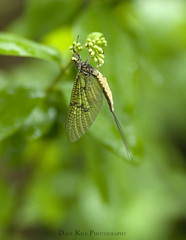
Understand the Life Cycle of Mayflies for Trout Fishing
A mayfly hatch is the grand finale in the seasonal play that returns annually for trout and anglers. This show begins the previous season with mature female mayflies, called spinners, laying their eggs on the surface of the water. The eggs shortly hatch into small larvae, which quickly change into nymphs.
The nymph phase of the mayfly is the longest and lasts approximately one year. Different species of mayflies can be found in different parts of a stream. Some prefer faster water and rocks, while others are only found at the end of pools in deep mud. During this time, the nymph grows and molts regularly. Molting involves the mayfly breaking out of its old skin and exposing a larger one underneath to protect it during the next growth cycle. The leftover soft shells are referred to as "shucks."
The emergence stage out of the water can be quick and dangerous for the transitional nymphs. Trout can find and aggressively feed on these insects, which may normally be hiding or burrowing at the bottom of a stream. Once ready to leave the water, the hatch begins. The emerger swims to the surface film, molts its skin, and exposes its wings.

The cloudy, grayish wings that emerge give the mayflies their name: "duns." The duns sit on top of the water and prepare their wings for flight, which can take seconds or minutes, depending on how fast they can take off. During this phase, mayflies can often be seen in large numbers sailing down the stream, with trout striking an easy food source. Once the dun escapes the water, it will head for the trees for several days.
During the maturation stage, a dun may molt several more times until it becomes a spinner. As spinners, male and female mayflies seek each other out only to mate. The female quickly lays her eggs back in the water, starting the cycle over again.
The cycle ends when the dead and dying mayflies drop into the stream. The spent wing spinner is the final opportunity for trout to feed on the last stage of this year-long production provided by the mayfly.
To learn more about mayflies, head over to the Hatch and Entomology Forum. Beginners can follow along and learn more in the Beginners Forum. A great online site to follow and learn more about the Latin names of mayflies is Troutnut and his "Aquatic Insects of our Trout Streams," a must-read!
Last edited:



